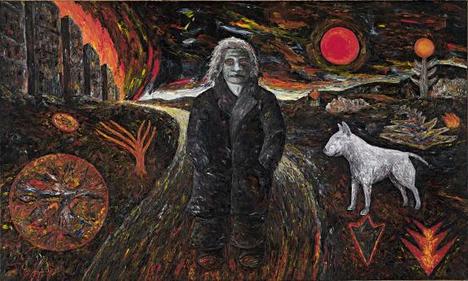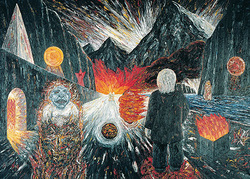Peter Booth
Peter Booth is one of the key figures of Australian art in the late 20th century, whose dark, sometimes apocalyptic, paintings are charged with an intense emotional power and with symbolic meaning.
“Peter Booth is possibly Australia’s most accomplished and respected figurative painter – I certainly think so,” says Paul Ryan.
Born in Sheffield in England in 1940, the son of a steelworker, Booth came to Australia with his family in 1957. He worked with his father in the steel mills until going to the National Gallery School in 1962 to study painting. He came to prominence in the 1960s with a series of minimalist black abstract paintings. By the late 1970s he had moved to nightmarish figurative paintings featuring monstrous allegories involving cannibalism, war scenes and mutilated bodies. Known for his visionary Australian landscapes, both urban and rural, Booth painted a series of snowy winter scenes in the 1990s after a trip to Russia.
His works are held in the National Gallery of Australia and all the other state galleries as well as in the Metropolitan Museum of Modern Art and the Solomon R Guggenheim Museum in New York.
Born in Auckland in 1964, Ryan moved to Australia as a child. He went to school in Australia, New Zealand, America and England and did a Bachelor of Creative Arts at the University of Wollongong. He has had regular solo exhibitions since 1988 and has exhibited in many group shows including the Blake Prize, the Dobell Prize, the Sulman Prize, the Fleurieu Landscape Prize, the Wynne Prize and the Sulman Prize. He has won eight art prizes including the 2006 Fleurieu Peninsula Art of Food and Wine Prize and the Faber Castell Drawing Prize.
“Peter Booth is possibly Australia’s most accomplished and respected figurative painter – I certainly think so,” says Paul Ryan.
Born in Sheffield in England in 1940, the son of a steelworker, Booth came to Australia with his family in 1957. He worked with his father in the steel mills until going to the National Gallery School in 1962 to study painting. He came to prominence in the 1960s with a series of minimalist black abstract paintings. By the late 1970s he had moved to nightmarish figurative paintings featuring monstrous allegories involving cannibalism, war scenes and mutilated bodies. Known for his visionary Australian landscapes, both urban and rural, Booth painted a series of snowy winter scenes in the 1990s after a trip to Russia.
His works are held in the National Gallery of Australia and all the other state galleries as well as in the Metropolitan Museum of Modern Art and the Solomon R Guggenheim Museum in New York.
Born in Auckland in 1964, Ryan moved to Australia as a child. He went to school in Australia, New Zealand, America and England and did a Bachelor of Creative Arts at the University of Wollongong. He has had regular solo exhibitions since 1988 and has exhibited in many group shows including the Blake Prize, the Dobell Prize, the Sulman Prize, the Fleurieu Landscape Prize, the Wynne Prize and the Sulman Prize. He has won eight art prizes including the 2006 Fleurieu Peninsula Art of Food and Wine Prize and the Faber Castell Drawing Prize.
PETER BOOTH

Painting
(1977) Peter BOOTH
Medium oil on canvas
Measurements182.5 x 304.0 cm
Booth exhibited Painting 1977, one of the most startling and powerful paintings in the history of Australian art. When it was first shown at Pinacotheca gallery in Melbourne, the gallery director Bruce Pollard declared it ‘beyond taste’, so radical did this work appear in the context of then-current minimalist and conceptual art. Booth’s aesthetic was his own, borne out of a genuine response to the private need to engender more emotion and context into his paintings.
The cloaked figure can be interpreted as the artist-everyman-prophet forced to begin a journey into an apocalyptic world as a consequence of humankind’s self-destructive violence and greed. The white dog can be read as a symbol of a new life force, and the sculptural profile as a symbol of the decay of civilisation. Other objects are interspersed with enlarged fragments from nature, echoing Booth’s belief that the part and the whole are but one and interchangeable.
(1977) Peter BOOTH
Medium oil on canvas
Measurements182.5 x 304.0 cm
Booth exhibited Painting 1977, one of the most startling and powerful paintings in the history of Australian art. When it was first shown at Pinacotheca gallery in Melbourne, the gallery director Bruce Pollard declared it ‘beyond taste’, so radical did this work appear in the context of then-current minimalist and conceptual art. Booth’s aesthetic was his own, borne out of a genuine response to the private need to engender more emotion and context into his paintings.
The cloaked figure can be interpreted as the artist-everyman-prophet forced to begin a journey into an apocalyptic world as a consequence of humankind’s self-destructive violence and greed. The white dog can be read as a symbol of a new life force, and the sculptural profile as a symbol of the decay of civilisation. Other objects are interspersed with enlarged fragments from nature, echoing Booth’s belief that the part and the whole are but one and interchangeable.
Untitled 1978

Booth's subject matter largely concerns the Australian landscape, both urban and rural, and the relationship between environment and individual, as well as the individual's capacity to create and destroy. And also what the world will be like in the future, humans as mutants.
Booth's landscapes are charged with emotion and symbolic meaning. Memories of his childhood in the blackened industrial landscape of Sheffield seem to infuse the work, especially his well-known apocalyptic figurative paintings, which look like images of the end of the world; illustrations for The Book of Revelation. These images contain an intense image of anxiety, evoking the aftermath of some terrible destruction, vividly pictured with menacing forms and agitated, heavily applied brushstrokes.
An example is Painting 1978 which has been described as challenging and disturbing the viewer by the artist’s choice of colour and method of painting. "The dramatic black and red, yellow and white composition suggests both an industrial and a natural wasteland". The heavy impasto paint texture describes, with vigour and intensity, flames, explosions, and unidentified nightmarish images. Contradictory forces pull us into the central inferno below the glacial mountain peaks, and showers of rock explode towards us.
Is it the artist himself who stands with his back to us, mesmerised by the scene, while grotesque metamorphosing figures stare out at us?"[1] Peter Booth has centred many of his paintings around his childhood in Sheffield England where he grew up during the war years and their aftermath.
Booth's landscapes are charged with emotion and symbolic meaning. Memories of his childhood in the blackened industrial landscape of Sheffield seem to infuse the work, especially his well-known apocalyptic figurative paintings, which look like images of the end of the world; illustrations for The Book of Revelation. These images contain an intense image of anxiety, evoking the aftermath of some terrible destruction, vividly pictured with menacing forms and agitated, heavily applied brushstrokes.
An example is Painting 1978 which has been described as challenging and disturbing the viewer by the artist’s choice of colour and method of painting. "The dramatic black and red, yellow and white composition suggests both an industrial and a natural wasteland". The heavy impasto paint texture describes, with vigour and intensity, flames, explosions, and unidentified nightmarish images. Contradictory forces pull us into the central inferno below the glacial mountain peaks, and showers of rock explode towards us.
Is it the artist himself who stands with his back to us, mesmerised by the scene, while grotesque metamorphosing figures stare out at us?"[1] Peter Booth has centred many of his paintings around his childhood in Sheffield England where he grew up during the war years and their aftermath.
